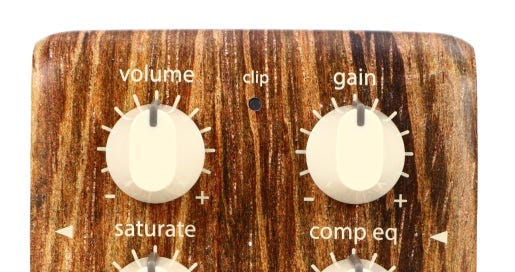Hi guys, I am back after being away for a bit. Today I want to talk about one of the most essential pedals on my electric violin pedal board—the L.R. Baggs Session Pedal. To me, other than the reverb pedal, this is the one pedal that I couldn’t live without when playing the electric violin. Interestingly, I didn’t discover this pedal until years into my electric violin playing experience. Now that I own this pedal, I have not played my electric violin without it for a single set!
So what exactly does this pedal do? Number one, I use it for its “saturation” feature. I turn the “saturate” knob to maximum level with the electric violin. It warms the sound of the electric violin and makes it sound much richer, more like a sound of an acoustic violin. If plugged straight into an amp, an electric violin can sound thin and brittle, not so pleasant to the ear. However, with the saturation, the electric violin sounds so much “creamier” and richer and soothing to listen to.
This effect is most evident on the high E string of the electric violin. Typically, the E string doesn’t sound great on the electric violin, in comparison to the other lower strings. It may has to do with the thinness of the string? Anyways, saturation enhances the sound of every note I play on the E string, and I can play with so much more confidence and not worry about sounding bad on the higher notes.
The second important feature on the Session pedal is the Compression EQ. When I was playing my 5-string YEV with the pedal I have the Comp EQ on a low setting, because it didn’t make that much of a difference in the sound. But when I started playing my 6-string Jordan in recent years, I figured out how the Comp EQ helps greatly on this particular violin.
On the 6-string Jordan, the F string, the lowest string, is much louder than the A and E strings, because it is a much thicker string! The thicker the string, the louder the volume when played with a bow. So, through my amp, the F string was overpowering the higher strings in turns of volume, and it made me play the F string much less because it was just way too loud.
Then, I realized that I can solve this problem by turning up the Comp EQ on the Session pedal. The compression feature decreases the loudest volume and increases the softer volume. Suddenly, with a good dose of Comp EQ, the F string’s volume came down and the entire string became more manageable to play! The F string volume became more in line with my E string volume, and I could play naturally without worrying about my sound. Praise God!
So, for a 4-string or 5-string electric violin, the Comp EQ doesn’t do that much, but for the 6-string, the Comp EQ is an indispensable tool in taming the F string! I suspect you can use other compression pedals to do the same trick, but with the saturation and compression features together in one pedal, you save the space on your pedalboard by not needing to get another pedal. (Plus saving money as well!)
Other features on the Session pedal includes Volume and Gain. The more you increase the Comp EQ, the lower the overall volume of the sound will be, so you should turn up the volume level the more you use the Comp EQ. The volume is also a very handy way to increase or decrease the overall volume of the electric violin during a live set.
In conclusion, the LR Baggs Session pedal is a super important pedal to have for the electric violin. It will definitely make your electric violin sound richer and warmer. You won’t regret getting it!





